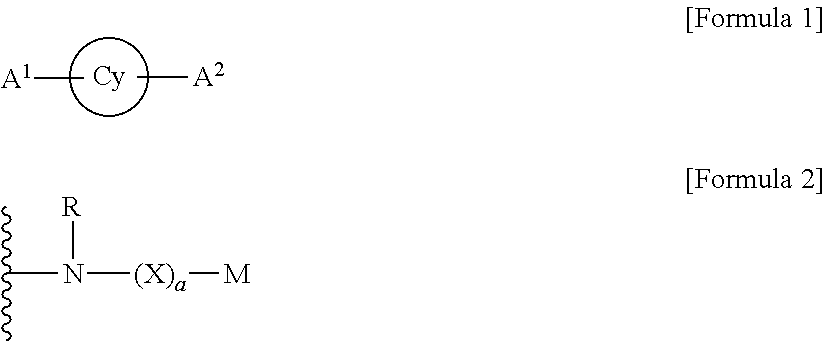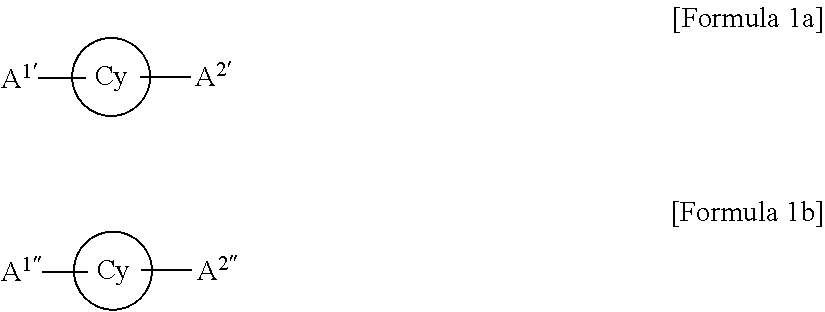Polymerization initiator, modified conjugated diene-based polymer, and methods for preparing them
initiator technology, applied in the field of polymerization initiator, a conjugated diene-based polymer modified technology, can solve the problems of small improvement effect by mixing, poor processing effect, and defect of low wet traction of materials, and achieve excellent physical properties, improve reactivity with a modifier, and high vinyl content
- Summary
- Abstract
- Description
- Claims
- Application Information
AI Technical Summary
Benefits of technology
Problems solved by technology
Method used
Image
Examples
preparation example
Preparation of Polymerization Initiator of Formula 3-1 Below
[0026]To a 3 L, four-neck round-bottomed flask to which an agitator, a thermometer, a dropping funnel and a Schlenk line were connected, 8 mol (1105.68 g) of potassium carbonate was added, the pressure was reduced, and moisture was completely removed. Then, under an argon atmosphere, 4 mol (629.76 g) of 1-bromo-3-chloropropane, 1 mol (88.15 g) of t-butyl methyl ether, and 1 mol (84.16 g) of cyclohexane were added thereto and stirred at 0° C. at 300 rpm. 2.4 mol (341.38 g) of N,N′-dimethyl-1,2-cyclohexanediamine was injected thereto via a dropping funnel over 1 hour, and after completing the injection, the temperature was elevated to room temperature and the reaction was performed. After completing the reaction, 400 ml of cyclohexane was added and sufficiently stirred, and then, remaining HBr was removed using a sodium hydrogen carbonate saturated aqueous solution. After that, salts were removed using distilled water and bri...
example 1
Preparation of Modified Conjugated Diene-Based Polymer
[0028]To a 20 L autoclave reactor, 270 g of styrene, 710 g of 1,3-butadiene, 5000 g of n-hexane, and 0.9 g of 2,2-bis(2-oxolanyl)propane as a polar additive were added, and the inner temperature of the reactor was elevated to 40° C. When the inner temperature of the reactor reached 40° C., 4.3 mmol of a compound represented by Formula 1-1, which was prepared in Example 1 was injected into the reactor, and an adiabatic heating was performed. After finishing the adiabatic heating and after about 20 minutes, 20 g of 1,3-butadiene was injected. After 5 minutes, 4.3 mmol of bis(diethoxymethylsilylpropyl)-N-methylamine was injected and reacted for 15 minutes. Then, the polymerization reaction was quenched using ethanol, and 45 ml of a hexane solution in which 0.3 wt % of a butylated hydroxytoluene (BHT) antioxidant was dissolved was added thereto. The polymer thus obtained was injected into hot water heated with steam, stirred to remov...
example 2
Preparation of Modified Conjugated Diene-Based Polymer
[0029]A modified conjugated diene-based polymer was prepared by performing the same method described in Example 1 except for using N,N-bis(triethoxysilylpropyl)aminopropyl-1-imidazole instead of bis(diethoxymethylsilylpropyl)-N-methylamine.
PUM
| Property | Measurement | Unit |
|---|---|---|
| molar ratio | aaaaa | aaaaa |
| running resistance | aaaaa | aaaaa |
| abrasion resistance | aaaaa | aaaaa |
Abstract
Description
Claims
Application Information
 Login to View More
Login to View More - R&D
- Intellectual Property
- Life Sciences
- Materials
- Tech Scout
- Unparalleled Data Quality
- Higher Quality Content
- 60% Fewer Hallucinations
Browse by: Latest US Patents, China's latest patents, Technical Efficacy Thesaurus, Application Domain, Technology Topic, Popular Technical Reports.
© 2025 PatSnap. All rights reserved.Legal|Privacy policy|Modern Slavery Act Transparency Statement|Sitemap|About US| Contact US: help@patsnap.com



